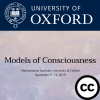Aaron Sloman - Why current AI and neuroscience fail to replicate or explain ancient forms of spatial reasoning and mathematical consciousness?
Aaron Sloman
School of Computer Science, University of Birmingham, UK
Most recent discussions of consciousness focus on a tiny subset of loosely characterized examples of human consciousness, ignoring evolutionary origins and transitions, the diversity of human and non-human phenomena, the variety of functions of consciousness, including consciousness of: possibilities for change, constraints on those possibilities, and implications of the possibilities and constraints -- together enabling extraordinary spatial competences in many species (e.g. portia spiders, squirrels, crows, apes) and, in humans, mathematical consciousness of spatial possibilities/impossibilities/necessities, discussed by Immanuel Kant (1781). (James Gibson missed important details.)
These are products of evolution's repeated discovery and use, in evolved construction-kits, of increasingly complex types of mathematical structure with constrained possibilities, used to specify new species with increasingly complex needs and behaviours, using lower-level impossibilities (constraints) to support higher level possibilities and necessities, employing new biological mechanisms that require more sophisticated information-based control. Such transitions produce new layers of control requirements: including acquisition and use of nutrients and other resources, reproductive processes, physical and informational development in individual organisms, and recognition and use of possibilities for action and their consequences by individuals, using layered mixtures of possibilities and constraints in the environment, over varying spatial and temporal scales (e.g. sand-castles to cranes and cathedrals).
I'll try to show how all this relates to aspects of mathematical consciousness noticed by Kant, essential for creative science and engineering as well as everyday actions, and also involved in spatial cognition used in ancient mathematical discoveries. In contrast, mechanisms using statistical evidence to derive probabilities cannot explain these achievements, and modern logic (unavailable to ancient mathematicians, and non-human species) lacks powerful heuristic features of spatial mathematical reasoning. New models of computation may be required, e.g. sub-neural chemistry-based computation with its mixture of discreteness and continuity (see recent work by Seth Grant).
Filmed at the Models of Consciousness conference, University of Oxford, September 2019.




